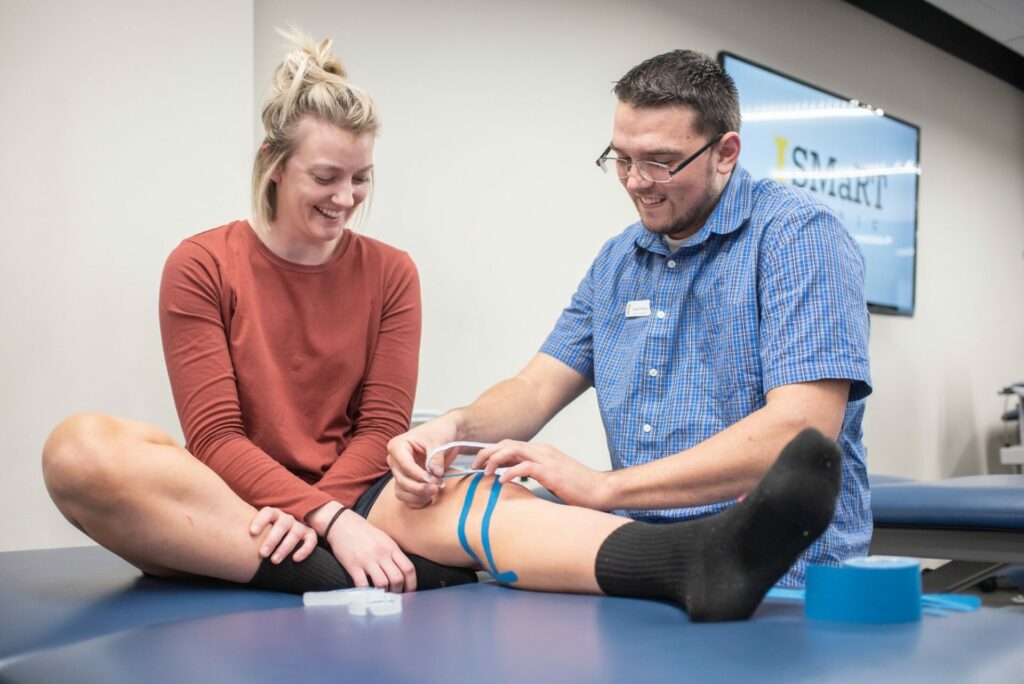Athletic Training and Physical Therapy are strongly related professions due to similar and complementary education, job settings, and skills sets. Many athletic trainers (ATs) and physical therapists (PTs) work together in different health care settings and will often collaborate in the care of the physically active patients. Additionally, ATs and PTs may also be part of inter-professional health care teams who work to provide patients with an integrative, whole-person approach to maximize patient care. The professions, however, do have differences. For example, ATs often have a greater focus on injury prevention, acute and emergent care, and working with athletes and the physically active population prior to, during, and after injury; PTs often focus on patients who have already suffered an injury and may be more likely to work with patients who are not part of the physically active population.
Overlap, confusion, and ambiguity between the professions is one of the challenges for students who are deciding between pursuing a career in athletic training versus physical therapy. Another challenge is understanding the different educational requirements for becoming an AT or a PT. To become a certified athletic trainer, one must graduate from an athletic training program accredited by the Commission on Accreditation of Athletic Training Education (CAATE); the current standard is that students must earn a professional master’s degree in Athletic Training. Graduates of an accredited athletic training program must also pass the Board of Certification (BOC) Exam to earn their professional credential. Certified athletic trainers must also be credentialed in most states to practice, with the majority of states regulating the profession with licensure. Most athletic training master’s degree programs are two-year programs that require a bachelor’s degree and specific prerequisite coursework for admission; however, some programs offer accelerated options (i.e., 3+2 programs) with undergraduate preparatory components.
Physical therapy is similar to athletic training in that one must graduate from a physical therapy program accredited by the Commission on Accreditation in Physical Therapy Education (CAPTE) to become a PT. However, the physical therapy profession requires students to graduate from a professional doctoral degree program in Physical Therapy. Graduates of an accredited physical therapy program must also pass the National Physical Therapy Exam (NPTE), which is maintained by the Federation of State Boards of Physical Therapy, and a licensing exam that varies by jurisdiction. Physical therapists must be credentialed to practice in a state with every state requiring licensure. Most physical therapy doctoral degree programs are three-year programs that require a bachelor’s degree and specific prerequisite coursework for admission.
When it comes to job settings you will find some similarities and differences as well. Traditionally, athletic trainers are found in high school, college/university, or professional sports settings. They are on the field or in the clinic every day working with athletes to prevent injury or with patients to rehabilitate following injury. Physical therapists can be involved in these settings but tend to be more behind the scenes assisting with the rehabilitation process, especially in long term cases. Athletic trainers can also be found in the industrial setting providing education and training for the prevention of work-related injury as well as rehabilitation following injury. Typically, physical therapists are found in in-patient (hospital, skilled nursing facility) or out-patient clinics working with patients from pediatrics to geriatrics with varying types of conditions. Athletic trainers are qualified to work in the clinic setting but tend to be limited in what skills they can perform due to restrictions with insurance billing. Both professions play a vital role in the healthcare team and it is important for both groups to work together in the best interest of their patients no matter what setting they are in. When it comes time to make a decision about which profession is right for you it is important to consider all of these different variables and find something that fits with your career goals.
The athletic training programs at the University of Idaho value the potential benefits of an integrative approach to health care and the strengths of each profession. We offer a professional master’s degree program that offers two routes for admission: an accelerated program (i.e., 3+2 program) for those without a bachelor’s degree and the traditional model for those who have already earned a bachelor’s degree. We also offer an advanced-practice doctoral degree program in athletic training (DAT), which was the first DAT program in the country. We have unique tuition models that do not include out-of-state fees, but are inclusive of tuition, textbooks, and additional manual therapy certification coursework.
Thus, our programs are committed to preparing students to become outstanding athletic trainers who excel in the traditional domains of the profession; however, we also develop students’ advanced skills to redefine the expectations of a career in athletic training. We provide students with ample opportunity to experience clinical settings needed to work as part of an integrative team, while also providing advanced training expected to be found in expert clinicians working with physically active patients regardless of whether that clinician is focused on working in an industrial job setting focused on injury prevention, providing traditional athletic training services for a sports team, or working in an outpatient rehabilitation clinic collaborating with various health care providers to maximize rehabilitation outcomes. Our expectation is our graduates will have the skillset to exceed the expectations of an AT or PT working with the physically active population across the various employment settings, while also being prepared to redefine excellence in patient care in these settings.
